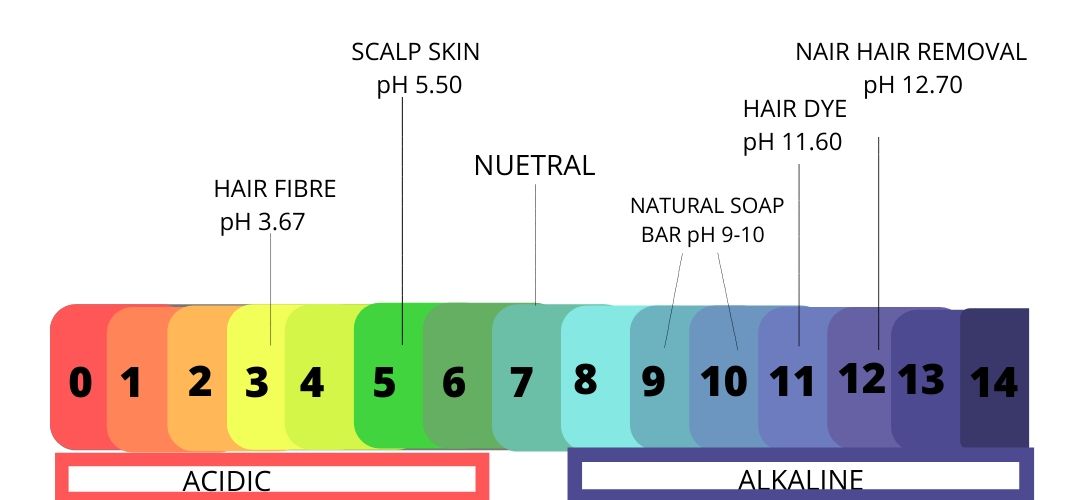
Why I Don't Make Soap Shampoo Bars
Share
Table of Contents
At heart, I'm a soap maker. I love everything about natural soap making.
BUT I would never, EVER, consider using soap to shampoo my hair.
Designing and making a soap based shampoo bar would be easy for me, I already have all the raw ingredients, the experience and the equipment. So making a soap bar and calling it shampoo would be the easy option.
However, after much research, I opted to focus on making pH balanced solid shampoo bars, using naturally derived organic and plant derived ingredients.
In a nutshell the pH of soap is too high, waaay too high for hair, in fact it is damaging to hair.
The use of a blend of naturally derived gentle surfactants and organic oils and essential oils allows me to follow my ethos of producing, safe, eco friendly, natural personal care products, free of palm oil and micas, presented in zero waste packaging.
It's important to me that my products perform on par or better than their traditional counterparts.So, I wanted to be able to incorporate panthenol, hydrolyzed rice proteins and other natural goodness into my shampoo bars.
 I need to emphasis how great I think handmade natural soaps are and how delighted I am to see so many flourishing natural soap businesses in Ireland. The first cosmetic product I ever made was a natural soap. I was hooked from the start. I love everything about natural soap making. I love researching the benefits of ingredients and the process of soap making, the un-moulding and cutting and stamping and above all the fantastic skin feel of the finished products. It is hugely satisfying! My Soap Bars are made from Organic, butters, oils and include fresh Atlantic seawater and Organic essential oils, are palm oil free and don't contain artificial colourants or micas, (because I refuse to support those industries but that's a whole other blog post). My natural handmade soaps are unique in that I have combined 2 traditional soap making techniques to produce soaps that have a rich creamy lather, high glycerin content and lather in soft water, hard water and even salt water....BUT.. let me say it again. I would never EVER use a lye or a melt and pour based soap on my hair.
I need to emphasis how great I think handmade natural soaps are and how delighted I am to see so many flourishing natural soap businesses in Ireland. The first cosmetic product I ever made was a natural soap. I was hooked from the start. I love everything about natural soap making. I love researching the benefits of ingredients and the process of soap making, the un-moulding and cutting and stamping and above all the fantastic skin feel of the finished products. It is hugely satisfying! My Soap Bars are made from Organic, butters, oils and include fresh Atlantic seawater and Organic essential oils, are palm oil free and don't contain artificial colourants or micas, (because I refuse to support those industries but that's a whole other blog post). My natural handmade soaps are unique in that I have combined 2 traditional soap making techniques to produce soaps that have a rich creamy lather, high glycerin content and lather in soft water, hard water and even salt water....BUT.. let me say it again. I would never EVER use a lye or a melt and pour based soap on my hair.
I'm a science geek, so a lot of my choice is science based, it's all about pH and the chemistry of the hair,
Bear with me, while I delve into the reasoning behind my choice.
What is pH?
pH is a measure of how acidic or basic (alkaline) a substance is. The pH scale varies from 1 to 14. A substance is considered to be neutral at pH 7.0, alkaline above pH 7.0 and acidic below pH 7.0

A little bit of hair chemistry?
The pH of a healthy hair shaft pH is 3.67, and is therefore considered acidic. Hair in this state will carry a positive charge (+). You know those hair commercials where you see strands of hair with little scales on them? Well that's actually a true thing. This is what a healthy hair strand looks like. The outside layer (cuticle) is closed, protecting the inner layer and locking in moisture.

Cool isn't it? The hair is extremely sensitive to the pH of products applied to it. Now lets take a look at what you might expect to see If you expose the hair shaft to ph levels above 7.00. Now, the hair strands become negatively charged (-), this results in those little scales of keratin opening up.
Now, the problem is, those little scales will snag each other and neighboring strands and in no time at all your hair is a hot tangly mess.
So, an alkaline pH ie: pH above 7.00 will increase the negative electrical net charge of the hair fiber surface and, therefore, increase the friction between the fibers. Friction is the main cause of frizz.
But the bad news doesn't end there. Because the cuticles are open, water can now enter into the inner layers of the hair strand. This is not good news for your hair! The water hydrates your inner strand, think of the inner layer like a sponge, it soaks up all that water and those hard scales outside it just shatter and fragment and the very innermost layer (axis) cracks and breaks.
Why is the pH of a shampoo bar important?
So, when you're designing a shampoo, you definitely want the pH to be below 7, to protect the hair but you also have to take into account the fact that the shampoo will be rubbed into the scalp. Scalp = pH 5.5; healthy hair = pH 3.67. What to do?
According to scientific research the optimum pH for shampoo is pH 5.00 - 5.5, conditioners ideally have a slightly lower pH ie more acidic, to close those cuticles right down again and prevent long term damage. This is the reason, I always recommend using one of my conditioner bars after shampooing. Solid conditioner bars are different to traditional conditioners in that they do not foam and are not rubbed into the scalp but instead are smoothed along the hair strand to release the nourishing, softening and moisturising ingredients....but again, this is another blog post.
Now, let's take a look at the ph of some common products, including natural handmade soap.

Yep. You read that right, natural soap with a pH level of 9-10 is only a few points away from Nair hair removal cream and very far away from the optimum pH of shampoo. Hair removal cream basically dissolves hair.
So, the science convinced me that maybe soap wasn't the best base for a solid shampoo bar. But I kept on researching. I'm a member of a US based soap making forum and the US were early adopters of shampoo bars and they have been on the market there for many years, while in Ireland shampoo bars are just starting to gain popularity. While some members of the forum still strongly extol the virtues of soap shampoo bars, many do not. At the very least, it seem's reasonable that sellers of soap based shampoo bars advise their customers to follow up with a vinegar rinse (vinegar is acidic) to close back down those cuticles. Here are a few snippets of soap makers talking about their experiences of long term use of their own soap shampoo bars. There are many more like this.


Finally, there appear to be many people in many countries, making and successfully using soap bars to wash their hair, but a follow on cider rinse is crucial to success. If some one tells you that their soap has a low pH, run like the wind..it is chemically impossible, bar soap stops being soap below about pH 8.7 and becomes a gluey, slimy mess.
It's just not for me. I shy away from risk. I prefer to make pH balanced shampoo and conditioner bars that I know for certain and for sure have no possibility of damaging anyone's hair.


1 comment
loved this and thank you :-)